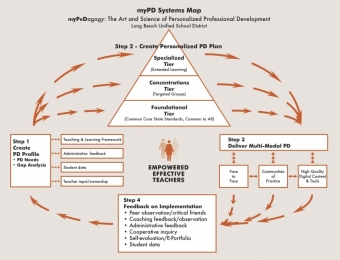Districts know all too well the disconnect between what products promise and what they actually deliver. Often they have to settle for something that might not perfectly fit their needs, but gets close enough.
But what if schools could design their own solutions, and open them up to companies who were ready for the challenge?
That’s the challenge Long Beach Unified (LBUSD) took on. Ranked as one of the most promising school systems in the world, the district partners with teacher training programs at nearby universities to create a pipeline of potential teaching candidates trained in what others call “The Long Beach Way.” Not only do teachers get support from coaches deployed throughout the district, but they also have their own professional development resource center they can physically visit to get help from highly regarded-peers.
In 2012, the Gates Foundation invited the district to respond to the iPD challenge: a $5 million opportunity for districts to design their own personalized professional development system. Long Beach laid out plans for a PD system that they called the “Disneyland for educators.” Here’s the journey--and why the industry wasn’t quite ready to build the Magic Kingdom.
First Steps
The project was a two-step process. The first part began with the district sending a 15-question survey to over 4,000 certificated educators in January 2013. Five-hundred seventy-two teachers responded with insights on their current experiences and potential areas for growth.
Based on the results, over 150 teachers spent one full day designing exactly what the new system would do. They identified how teachers operated in the current PD system and how they might behave in an ideal system where everyone got the training and support they needed and wanted. “The teachers just got to dream: ‘What would the perfect professional development system look like for you?’” says Program Administrator, Nader Twal.
“At first the iPD team who had to execute the dream were nervous. They felt an extreme responsibility to make the teacher's dreams come true,” says Twal.
But when the principals saw the system that their teachers had designed, many were excited. Several jumped onboard to join the design team to offer use cases of their own. “I thought of it as a chance to change the scope of my job in the next five years,” says one administrator.
“Principals were really excited about the opportunity to use innovative PD at their site. They were very excited about the prospect of communicating and supporting teachers beyond just face to face,” says Chris Eckert, iPD team leader and Program Specialist for Long Beach Unified.
What Disneyland Looked Like
The system they designed evaluates teachers’ needs based on students’ academic performance data, teachers’ past PD courses, self-evaluations and administrative feedback. Once these needs are assessed, the system helps the teacher create a personal learning plan and offers a list of online and offline professional learning opportunities. The final step in the system gives teachers feedback on their growth by automatically pulling future data from student academic performance data, coaching feedback, and observations.

The system map illustrates the design created by the Long Beach teachers and administrators. In the system map above, each arrow represents the path that the system leads the teacher to take. This image is proprietary to LBUSD.
Each step is automated and happens within the system, meaning that teachers would not have to go to a third-party website or use video conferencing software.
“The experience of professional development is in the arrows. There are a lot of companies that can provide the white spaces but the arrows are where the experiences live,” says Twal.
Industry’s Response
The district released its Request for Proposals (RFP) to the edtech community in September 2013, asking companies to share how their existing products could be customized to fit the system they designed.
“When the bid hit the street, you could immediately tell it had a vision in it. It wasn’t what I would consider a boilerplate bid,” says Joni Wing, Sales Director at TruenorthLogic, one of those that responded.
After a month, three companies responded and were invited to demonstrate in front of 30 teachers and district administrators. Each demo ended in a Q&A session. “That’s where we got past the smoke and mirrors and got to the actual capacity of the product,” says Twal.
Quickly, educators saw the gap between their dream and what existed in the marketplace. “The frustrating part of it was asking them, can you do x, y and z. They say yes, yes and yes. But by the end of the day we found out that they can’t do any of it,” says one teacher on the design committee.
After weeks of deliberation, comparing evaluations, and checking references, “we felt we had to choose a system that could build infrastructure before content,” says Twal. The district eventually settled on Truenorthlogic, believing that it was most willing to work with the district to do extensive customizations, for the final bid of $679,874 over five years.
LBUSD plans to roll out an alpha pilot of the Truenorthlogic system with 100 educators in the winter and spring of 2014. It will then begin with a soft launch of the whole program in 2014-15 and a system-wide adoption at the beginning of the school year in 2016-17.
Is The Industry Ready for Disneyland?
With about half a million dollars on the table and the chance to work with one of the top districts in the world, why did only three companies take the bait and respond to the RFP?
It used to be that districts had a list of general requirements that most companies could meet. However, as districts become more aware of their specific needs, their demands narrow down the field of potential candidates to those who are agile enough to tweak their product to meet specific needs of a district.
For vendors, it can be hard to keep up, especially for smaller companies. Large companies might have full time staff members who only work on RFP applications. However, for smaller companies that might take a month’s worth of work for a gamble that might not pay off.
Companies also find it unwise to build for only one user “For startups especially, it’s hard,” says Smarter Cookie Founder Tess Brustein, “If we were to say ok - we are going to build everything around this one district but that solution only works for one customer, we don’t survive.”
However, for districts like Long Beach, the old way of doing things might not be enough. Their teachers expressed hope that in the future edtech companies can collaborate more to help districts realize their dreams.
“We are feeling a big responsibility to the teachers in this district, to execute their dreams. We want to build Disneyland, we know what it looks like when it’s up and running. The reality is we have to look at it incrementally. You just have to start building a ride,” says Twal. And that’s exactly what Long Beach is setting out do over the next year.


